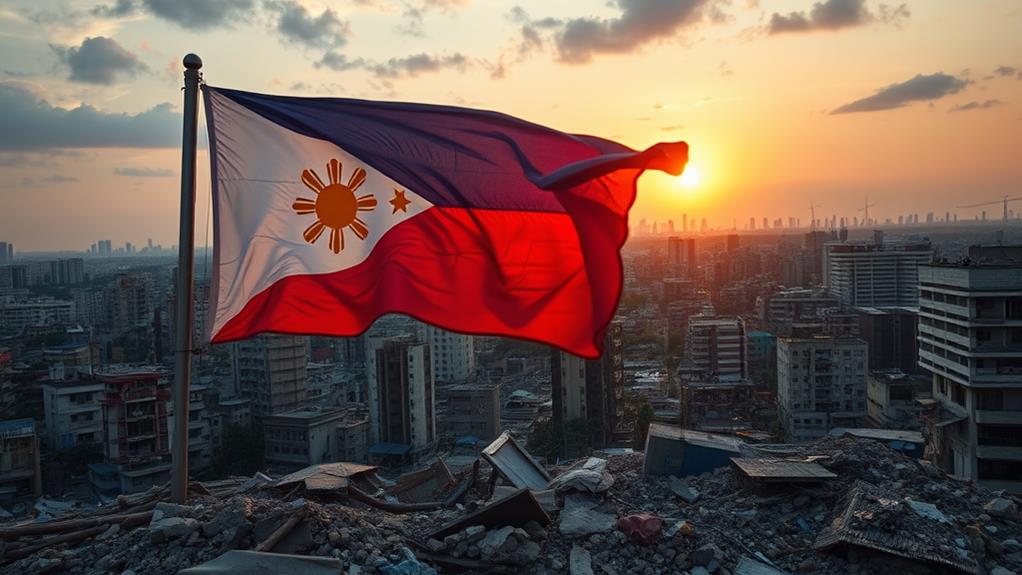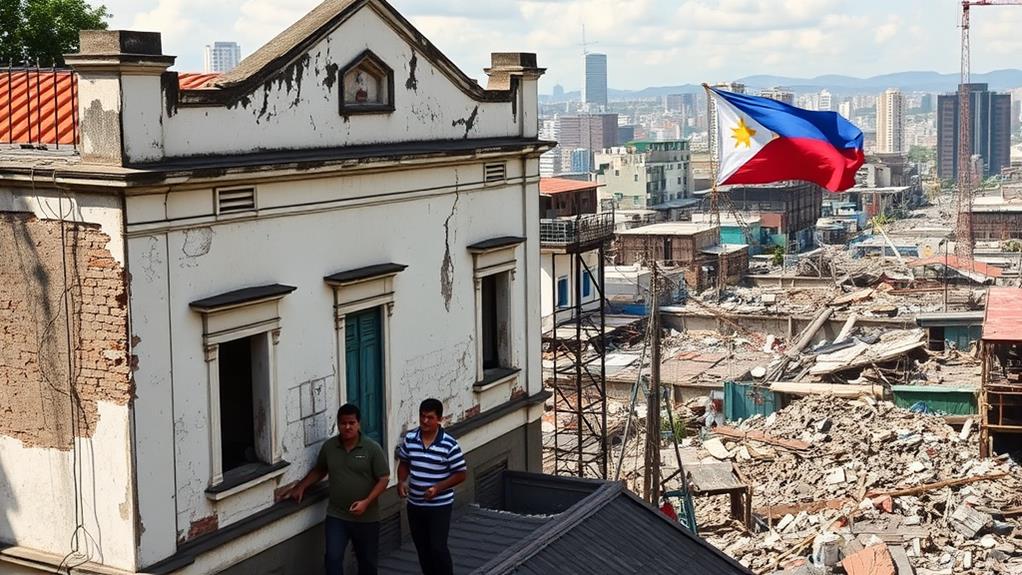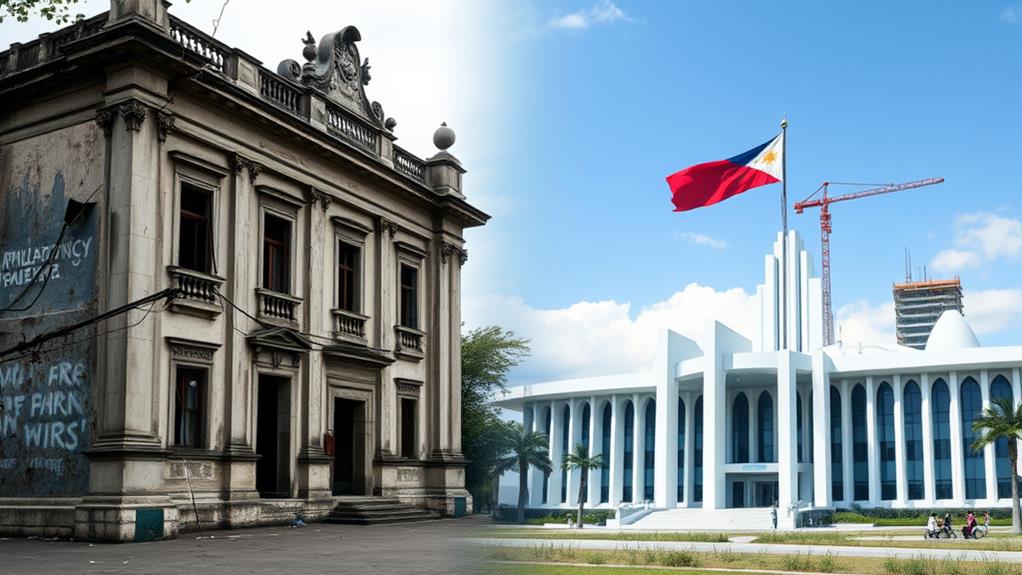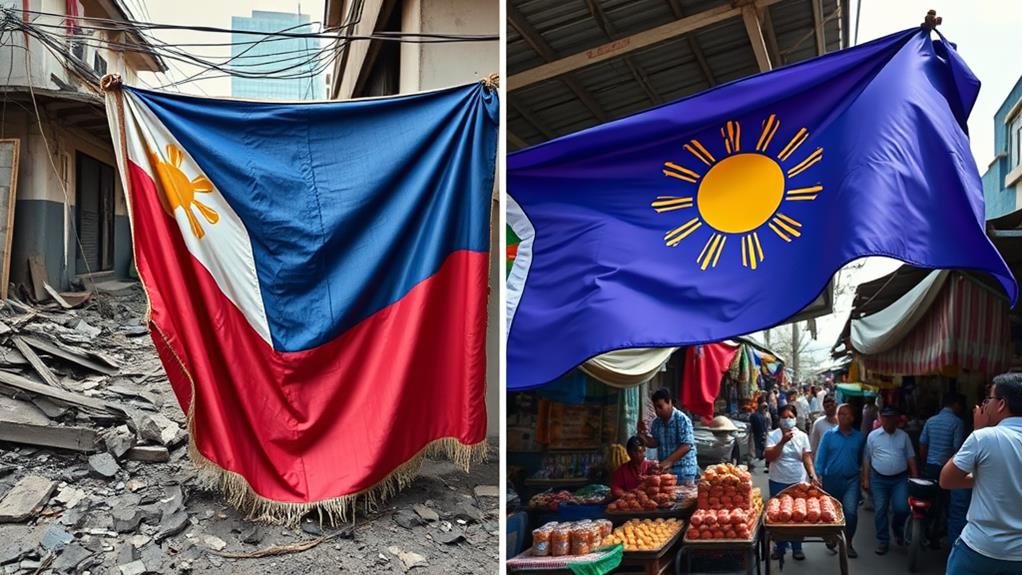The Philippines faced significant challenges after World War II. The country was ravaged by the Japanese occupation, which resulted in nearly one million civilian deaths and widespread destruction. This devastation set the stage for a daunting nation-building process.
The country gained formal independence from the US in 1946, but it was marred by corruption, unemployment, and economic hardship. The US provided insufficient aid to support rehabilitation efforts, making it difficult for the Philippines to rebuild.
The nation's population of 18 million struggled to recover from the loss of over a million Filipinos during the war.
Ongoing US influence, social unrest, and agrarian discontent further complicated the path towards true independence and self-determination. The complexities of the past continue to shape the nation's future.
For example, the US retained significant control over the Philippines' economy and politics, limiting the country's ability to make its own decisions. Additionally, social unrest and agrarian discontent led to the formation of the Hukbalahap, a communist guerrilla movement that sought to overthrow the government.
Historical Context of Liberation
The Philippines suffered greatly under Japanese occupation during World War II. This occupation lasted nearly four years and resulted in approximately one million civilian deaths. The Japanese occupation was marked by widespread destruction, suffering, and loss of life, which had a devastating impact on the country and its people.
The initial defense against the Japanese invasion was led by General Douglas MacArthur. He commanded US and Philippine forces in significant battles at Bataan and Corregidor.
As the war turned in favor of the Allies, General MacArthur's landing in Leyte on October 20, 1944, marked the beginning of the liberation of the Philippines. The subsequent military campaigns were intense, resulting in substantial civilian casualties and the devastation of major cities.
Despite the challenges, the Philippine Commonwealth government was reinstated after the war. However, the country faced significant economic challenges, including rampant unemployment and corruption, as it transitioned to independence.
The path to Philippine independence was paved, and on July 4, 1946, the nation formally gained independence, marking the end of U.S. colonial rule. Understanding the historical context of liberation is essential to recognizing the challenges that lay ahead for the Philippines.
Rebuilding a Nation Amidst Ruin
Rebuilding a Nation Amidst Ruin
After World War II, the Philippines faced the daunting task of rebuilding a nation amidst ruin. Manila lay in ruins, and unemployment and corruption were rampant. The Philippine War Damage Commission was established to address claims for war-related property losses, highlighting the extensive damage that left the country in need of substantial rehabilitation funds.
Rebuilding required a massive influx of resources. The initial U.S. aid of $620 million sought through Senator Tydings' rehabilitation bill seemed like a lifeline. However, mismanagement and corruption hindered the effective distribution of emergency food aid and resources, further exacerbating the challenges.
The sheer scale of human loss was staggering. Over 1 million Filipinos died during the war, leaving a population of approximately 18 million struggling to come to terms with the devastation.
As the country navigated the complexities of rebuilding, it also had to contend with the continued influence of foreign powers, as seen in the Philippine Trade Act of 1946, which formalized U.S. economic dominance.
Independence and Its Challenges

The Philippines gained independence from the United States on July 4, 1946, ending over 400 years of colonial rule.
This significant milestone was marked by severe post-war challenges, including widespread destruction, economic hardship, and the loss of approximately one million Filipino lives during World War II.
The country's independence was tempered by ongoing American influence, as evidenced by the U.S.-Philippines Military Bases Agreement, which raised concerns about Philippine security.
To revitalize the national identity and heritage, preserving traditional crafts became essential. This effort was crucial for community cohesion and pride, reflecting the country's diverse cultural influences and traditions.
Reviving craftsmanship initiatives supported local economies through artisan livelihoods and enhanced tourism through unique, handcrafted products.
The Philippines urgently needed to rebuild and revitalize its economy, but the road to recovery was fraught with obstacles.
Post-War Rehabilitation Efforts
Rebuilding a nation required a multifaceted approach, and post-war rehabilitation efforts were crucial.
The Philippine War Damage Commission played a vital role in addressing claims for war-related property losses, with initial estimates for damages reaching $1.2 billion.
The U.S. Congress allocated $520 million for rehabilitation, but this fell short of the estimated needs. This led to:
- Widespread unemployment, which exacerbated social unrest.
- Rampant corruption in government, hindering the recovery process.
- Dire economic conditions, with essential services in disarray and black markets thriving.
- The Philippine Trade Act of 1946, which formalized U.S. economic dominance and established provisions for peso stability and extended duty-free trade with the United States.
Despite the influx of U.S. aid, the economic and social reforms necessary for long-term recovery were inadequately addressed. This led to:
- Increased public discontent and the rise of movements like the Hukbalahap insurrection.
- Corruption and inadequate recovery efforts hindering the nation's ability to rebuild and move forward.
Nation-Building and Its Obstacles

Rebuilding a Nation: Challenges and Obstacles
After World War II, the Philippines was left with the daunting task of rebuilding from the ruins. Nation-building wasn't just about reconstructing physical infrastructure, but also addressing deep-seated social and economic issues. The cultural identity of various ethnic groups, such as the Gaddang people and their traditional Bendian dance, played a vital role in fostering community connections and resilience during this challenging period.
Corruption in government and land reform were two significant obstacles to nation-building. The Hukbalahap movement, which emerged post-WWII, highlighted the discontent among peasants due to agrarian issues and the government's failure to implement effective land reform policies.
This led to increased social unrest, further complicating nation-building efforts.
U.S. policy in the post-war period prioritized the restoration of pre-war conditions and economic dominance, often sidelining the political and economic demands of ordinary Filipinos.
As a result, the nation-building process was slow and arduous, with the country struggling to break free from colonial legacies that benefited elites over ordinary citizens.
Social Order Vs Social Justice
As the Philippines rebuilt from the devastating effects of war, a pressing concern emerged: balancing the need for social order with the imperative for social justice. The government's inaction on ordinary citizens' demands led to widespread discontent, threatening social order.
Four key areas highlighted the tension between social order and social justice:
Agrarian issues: The government consistently rejected genuine land reform initiatives, perpetuating Agrarian issues and disconnecting the government from the majority of the population. For instance, the landlords retained control over vast tracts of land, leaving many farmers without access to arable land.
Political processes: The establishment of a formal nation-state in the Philippines occurred without true representation of citizens' will, leaving many feeling alienated from political processes. The lack of representation led to a sense of disconnection among citizens, who felt their voices weren't heard.
Economic inequality: Economic policies favored elites over the broader populace, perpetuating social inequalities and limiting access to resources for many Filipinos. The post-war era's economic policies, for example, allowed the wealthy to accumulate more wealth, widening the gap between the rich and the poor.
Social discontent: The government's inaction on ordinary citizens' demands led to widespread discontent, threatening social order. This discontent manifested in various forms, including protests and demonstrations, as citizens demanded change.
The question remained: how to balance the need for social order with the imperative for social justice to create a more equitable society.
Political Dynamics and Governance

The post-war Philippines faced a delicate political situation, where the central authority struggled to balance local autonomy with citizens' demands for representation and social justice.
The government's inability to address the legacy of colonial rule led to weak institutions and democratic deficits.
The emergence of political parties and movements, such as the Hukbalahap movement, demonstrated the people's desire for genuine governance.
However, the system was flawed, and the government failed to address key issues like agrarian reform.
Despite attempts at land reform, corruption and mismanagement persisted, driving citizens away from the government and fuelling revolutionary movements.
To overcome these challenges, the Philippine government must confront its governance issues head-on.
This requires strengthening institutions and addressing the people's demands for representation and social justice.
Economic and Social Movements
The roots of economic and social movements in the Philippines can be traced back to the pre-war era. In 1930, the Partido Komunista ng Pilipinas was formed to advocate for social reform in response to colonial exploitation and inequality.
The post-war period saw the rise of peasant-led insurgencies. The Hukbalahap movement, for instance, was driven by agrarian discontent and demands for land reform. This was a response to the failure of President Quezon's social welfare plans, which left significant economic issues unaddressed.
Economic policies heavily influenced by U.S. funding and interests often benefited the elite while neglecting the broader population's needs for genuine reform. Widespread discontent with the government's failure to implement meaningful land and economic reforms led to the emergence of resistance movements.
These factors ultimately led to the rise of economic and social movements in the post-war Philippines. People sought to address the country's deep-seated issues, including the need for land reform, social welfare, and economic reform that benefited the broader population.
How Did the Concept of Bayanihan Influence the Rebuilding of the Post-War Philippines?
The concept of Bayanihan, deeply ingrained in the filipino spirit cooperation, played a crucial role in the rebuilding of post-war Philippines. The collective effort and communal cooperation helped communities come together to rebuild homes, infrastructure, and livelihoods, showcasing the strength and resilience of the Filipino people.
Rebuilding a Nation's Identity

Rebuilding a Nation's Identity
After a devastating war, a nation's identity is often put to the test. The Philippines, for instance, struggled to establish a stable government and a sense of self in the post-war era. This was due to the influence of the U.S. on its governance and economy, which left many Filipinos feeling disconnected from the nation-state.
The quest for social justice was a response to foreign domination and internal struggles against systemic inequalities. This is reflected in the works of Lualhati Bautista, who wrote about the impact of human rights violations on Filipino lives in her novels.
The Hukbalahap insurgency, for example, highlighted issues of agrarian reform, resonating with the populace's aspirations for equity and representation.
Education and cultural initiatives emerged as vital tools for fostering a cohesive national identity. Organizations like the Bataan Legacy Historical Society worked to raise awareness of Filipino contributions during WWII.
Rebuilding a nation's identity requires a nuanced understanding of its history, a commitment to social justice, and a willingness to challenge the remnants of colonialism.
Questions and Answers
What Happened in the Post-War Period in the Philippines?
The Philippines was left in shambles after the war. The country faced widespread destruction, with cities and towns reduced to rubble.
Unemployment was rampant, leaving many without a steady income. The estimated cost to rebuild was staggering, with $800 million in aid needed to recover from the devastation.
The government struggled to address these issues, and to make matters worse, the U.S. Congress denied benefits to Filipino veterans, sparking outrage among those who'd fought alongside American forces.
Meanwhile, the Hukbalahap movement gained traction among peasants who were discontented with the government's failure to implement meaningful land reform and its corruption.
This movement further complicated the nation's path to recovery, as it highlighted the need for social and economic change.
What Happened to the Philippines After the War Ended?
The Philippines faced devastating consequences after World War II. Cities like Manila lay in ruins, causing economic distress and widespread unemployment.
The U.S. allocated $620 million for rehabilitation, but corruption and mismanagement hindered its effective use.
As a result, the country struggled to rebuild, with inadequate funds for property losses and economic policies that maintained U.S. dominance.
This led to social unrest and insurgencies, ultimately fueling further instability.
How Long Did It Take to Rebuild Manila After Wwii?
The city's rehabilitation was a gradual process that spanned years.
Although the Philippine government established the War Damage Commission to address property losses, insufficient economic aid and corruption hindered progress.
It took until the late 1940s and early 1950s for Manila to fully recover from the devastating war damage, with significant challenges persisting throughout the rebuilding process.
What Was the Aftermath of the Philippine American War?
The Philippine-American War resulted in massive destruction and loss of life.
The war caused an estimated 200,000 Filipino deaths, making it one of the deadliest conflicts in Philippine history.
Infrastructure was severely damaged, with many cities and towns left in ruins.
The US established a colonial government in the Philippines.
Following the war, the US prioritized American interests, delaying self-governance for Filipinos.
This led to a nationalist movement, as many Filipinos sought independence and resisted American rule.